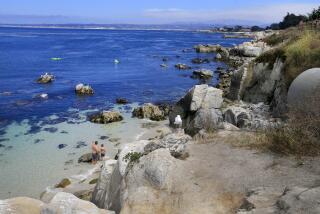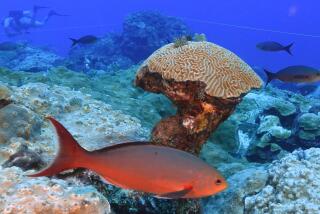A fish-eye view of a coral reef
- Share via
ABOARD THE NANCY FOSTER — Whirring over a sun-streaked patch of tropical seafloor, a submersible equipped with cameras is helping provide the most detailed maps ever recorded of underwater shelves and struggling coral reefs in the Caribbean off the U.S. territory of Puerto Rico.
The small machine, tethered to a 187-foot survey ship, was steered by remote controls over coral hills, sending a fish-eye view back to scientists who studied the images in hopes of restoring reefs weakened by man-made and natural threats.
More exact contours were mapped in an hour by video and multibeam sonar imagery than had ever been charted in the area.
“It’s neat getting the images because some of these spots are where Captain Cook’s ships were once dropping lead lines to get an idea of what was down there,” said researcher Mike Stecher, referring to the centuries-old practice of lowering weighted lines to map depth.
Scientists and observers oohed and aahed as they watched grouper or squirrel fish dart behind coral or sponges on images sent by the submersible to a control room on the Nancy Foster, a ship operated by the National Oceanic and Atmospheric Administration.
The maps generated by the NOAA team during an expedition along coastal stretches of Puerto Rico will help scientists gauge the health of dwindling coral habitats, some of which have been “bleached” and killed by changes in climate, according to the mission’s chief investigator, Tim Battista.
Reef-building coral -- a tiny polyp-like animal that builds a calcium-carbonate shell around itself, forming structures that provide refuge, breeding and feeding areas for thousands of marine creatures -- is under assault in the Caribbean and across the globe.
In Puerto Rican waters, shallow-water reefs are being severely stressed by coastal pollution and overfishing. Nearly half the coral in areas of the neighboring U.S. Virgin Islands died from disease outbreaks after months of warming waters in 2005.
Researchers have predicted that up to 60% of the world’s coral could die by 2030 if ocean temperatures and pollution levels continue to creep upward. Carbon dioxide and other greenhouse gases contribute to rising sea temperatures that are damaging the reefs.
NOAA marine biologist Mark Monaco said the U.S. agency had been undertaking the most extensive mapping study ever of reefs from the Atlantic to the Pacific, using a wide variety of imaging systems, to support natural resource management and save dwindling reefs.
“Coral reef ecosystems that we see today clearly have many stressors. You can’t pull down big ice cubes to help stop warming oceans, but we have a responsibility as humans to preserve these habitats,” Monaco said aboard the NOAA research vessel.
A key, Monaco said, is to protect these fragile areas by enforcing rules against overfishing, runoff from coastal developments and use of anchors.
New NOAA maps also will provide assistance to government authorities in fish conservation because hydroacoustic devices aboard the Nancy Foster can emit sonic waves underwater to count fish and chart how they are distributed, said Laura Kracker, a NOAA scientist aboard the research ship.






